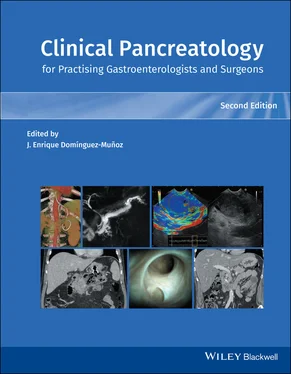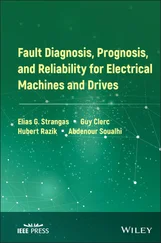Management of Symptomatic Walled‐off Necrosis
Indications and Timing for Intervention
Prior to undertaking drainage and debridement of WON, careful review in a multidisciplinary format is paramount. Regardless of the initial approach decided in an individual patient, appropriate interdisciplinary discussion is critical, with team approaches comprising gastroenterologists, interventional radiologists, pancreaticobiliary surgeons, and nutritionists. Regardless of the size of the collection, patients who are asymptomatic should not undergo interventions. This can only lead to complications. The indications for intervention on WON include symptoms of abdominal pain, nausea and vomiting, early satiety, and decreased oral intake; luminal obstruction including gastric outlet obstruction or pancreaticobiliary obstruction; or those with persistent infection despite broad‐spectrum intravenous antibiotics. It is important to remember that empiric broad‐spectrum intravenous antibiotics should be administered in patients with concern for infected necrosis prior to consideration for debridement. Conservative management with supportive care and intravenous antibiotics may frequently be able to effectively avoid the need for necrosectomy [13,14]. Historically, WON was managed surgically with multiple operative procedures required and associated significant morbidity. While endoscopic drainage of PP was first reported in 1985, endoscopic interventions for WON were not initially described until 1996, in which endoscopic drainage and debridement of necrosis was reported. Subsequently, Siefert and colleagues [15,16] in Germany reported endoscopic retroperitoneal necrosectomy in 2000. It cannot be stressed enough that endoscopic necrosectomy must be delayed until a clearly defined wall has developed, as rates of success for drainage and debridement are associated with the presence of a capsule, which traditionally is at approximately four weeks [17,18]. Besselink et al. [19] demonstrated in 53 patients with infected necrosis (83% with infected necrosis; 55% with preoperative organ failure) that there was a significant reduction in mortality with delayed surgical necrosectomy, the procedure having increasing benefit the further from date of initial admission (75% mortality if intervention at 1–14 days vs. 45% mortality at 15–29 days vs. 8% mortality at ≥30 days; P <0.001).
Choosing the Best Interventional Option: the Step‐up Approach
Historically, surgical debridement was the traditional management strategy for symptomatic necrosis with and without the presence of infection. This was done via an open approach with a wide drainage area and placement of multiple abdominal drains, usually with the need for repeat operative procedures over a prolonged period of time; reintervention rates from larger European and American series ranged from 30 to 70%, with associated morbidity and mortality estimated at 11–50% in some series [20–22]. In a series of 167 patients with necrotizing pancreatitis, 72% of whom had infected necrosis, surgical outcomes from a single‐step debridement and closed packing technique was evaluated and showed a 12.6% risk of reoperation, 29.9% rate of subsequent requirement for percutaneous interventional radiology drainage, and overall operative mortality rate of 11.4%. Additional complications included postoperative pancreatic fistulas (41%), enteric fistulas (15%), endocrine pancreatic insufficiency (16%), and exocrine insufficiency (20%), while 57% required prolonged admission to the intensive care unit [21]. Though necessary to surgically intervene at times, the substantial associated morbidity and mortality served as the foundation to seek other interventional avenues to improve the overall outcomes.
Beyond open surgical debridement, multiple additional therapeutic interventional options exist for the treatment and management of pancreatic necrosis. These options include endoscopic intervention, percutaneous intervention, and minimally invasive surgical approaches including video‐assisted retroperitoneal debridement (VARD). In the percutaneous approach, multiple large‐bore catheters are placed into the collections under imaging guidance and the cavities are regularly flushed to promote liquefaction and drainage. Percutaneous approaches are relatively safe, with low complications and mortality, and may be used to guide additional necrosectomy subsequently by providing an access tract, as well as allowing patients who would otherwise not be candidates to undergo endoscopic or minimally invasive surgical approaches. Because percutaneous approaches are primarily a flush and drain approach, as opposed to direct debridement, this may limit their efficacy. In systematic reviews, the efficacy of percutaneous drainage is estimated to be 44–55% in treating necrosis and avoiding the need for subsequent surgery, making percutaneous drainage an attractive potential option either as a bridge to other interventional options in an unfit procedural candidate or as destination therapy in approximately half of patients [23,24].
As new approaches continue to evolve, there is increasingly more evidence to substantiate the use of endoscopic necrosectomy, laparoscopic transperitoneal or video‐assisted retroperitoneal debridement, and percutaneous drainage. Cystgastrostomy with nasocystic irrigation for the treatment of WON was first reported in 1996, and transluminal direct endoscopic necrosectomy followed in 2000 [15,16]. Subsequently, there has been much work to further investigate the optimal management strategies and performance characteristics of each management strategy. Multiple initial studies demonstrated the efficacy of transgastric access into the retroperitoneum with debridement of necrotic tissue, followed by placement of stents into the collection to enable continued drainage [25–27]. The current standard of care when accessing these collections endoscopically is the use of EUS to confirm the location of the collection, characterize the collection, and ensure that there is no vascular structure in the interceding area between the puncture site and the collection [28].
Endoscopic transgastric necrosectomy was first compared to surgical necrosectomy in the randomized PENGUIN trial (Pancreatitis Endoscopic Transgastric vs. Primary Necrosectomy in Patients with Infected Necrosis) by Bakker et al. from the Dutch Pancreatitis Study Group, in which endoscopic necrosectomy led to a decreased proinflammatory response and was associated with a substantially reduced incidence of major complications or death (20% vs. 80%) [25]. In the PENGUIN trial, the endoscopic approach consisted of initial transgastric puncture followed by balloon dilation of the tract and subsequent drainage and necrosectomy, whereas the surgical approach first focused on VARD or laparoscopic debridement as opposed to open surgical necrosectomy if VARD was not possible. Subsequently, a step‐up management approach was proposed that primarily aims at control of any subsequent infection and aims for minimally invasive management strategies as opposed to open necrosectomy, with a stepwise progression from percutaneous to endoscopic to VARD or laparoscopic drainage and debridement. The step‐up approach was compared in the PANTER trial in which van Santvoort et al. [29] demonstrated a significant reduction in their primary composite end point of death or major complications in which this composite outcome was found in 40% of patients undergoing a minimally invasive step‐up approach compared to 69% of those undergoing primary open necrosectomy [relative risk (RR) 0.57, 95% confidence interval (CI) 0.38–0.87; P = 0.006]. Interestingly, in this initial study, laparoscopic necrosectomy was not part of the algorithm, and in the step‐up approach only a small proportion of patients underwent endoscopic necrosectomy whereas most underwent percutaneous drainage and then VARD.
Читать дальше












